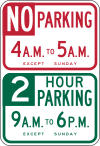Key:parking:condition
 |
| Description |
|---|
| Describes the legal properties of the parking. |
| Group: parking |
| Used on these elements |
| Status: deprecated |
| Tools for this tag |
|
This page documents the usage of the key parking:condition=* to indicate the legal properties of a parking lane or if parking is allowed on a road. It can be added to ways tagged with highway=*.
parking:condition=*describes the legal properties of the parking space. This tag is also the default value when used in combination with conditionals.parking:lane=*, a similar but different tag, is used to describe the physical properties of the parking space.
Both can be used independently of each other, they do not necessarily require the other.
- The key
parking:condition=*should always be used with the appended subtags:both,:left, or:right; indicating the side of the street they apply to.[1] - The roadway needs to be split up where any of the parking condition changes.
Parking conditions
The parking:condition tag describes the legal properties of the parking space. This tag is also the default value when used in combination with conditionals.
Note: Do not confuse condition with conditional. The former is part of the parking:condition tag while the latter is for conditional restrictions and only added at the end of a key.
| Key | Value | Description |
|---|---|---|
| parking:condition:side | free
|
The parking is free to use. If there is a time limit, add a parking:condition:side:maxstay=* tag
|
ticket
|
A ticket is required. This can be a physical ticket, electronic ticket via SMS or through an app, etc. If possible add the location of the ticket machine(s) nearby using the amenity=vending_machine + vending=parking_tickets tags.
| |
disc
|
A parking disc is required. Add a parking:condition:side:maxstay=2 hours tag to describe the time limit, for example 2 hours.
| |
residents
|
Add a parking:condition:side:residents=A tag. This means "parking only for residents with permission A" (With A being the identification of the permission).  | |
customers
|
This means you are only allowed to park here if you are a customer of the shop that owns this parking space (or a visitor of a site, or a guest of a hotel, or similar). If additional restrictions apply, such as a time limit, add those. | |
private
|
No additional information is required. This means you are only allowed to park here if you rented the parking space (or have a permission of the owner). | |
disabled
|
Usually, this parking space is not about free or paid. It requires being related to disabled persons or to have such permission. | |
loading
|
Parking is not allowed, but standing for loading or unloading is explicitly allowed. In contrast to no_parking, loading and unloading is explicitly designated, e.g. with a traffic sign, and depending on the legal situation, there is no or a different maxstay period.
| |
no_parking
|
No regular road user is allowed to park on the road. They may stop, though, to for example pick up/drop off a passenger, unload cargo or for other reasons as laid out in the local legislation. | |
no_standing
|
No regular road user is allowed to park on the road. They may stop, as long as they remain in the vehicle, to for example pick up/drop off a passenger or for other reasons as laid out in the local legislation. | |
no_stopping
|
No regular road user is allowed to stop their vehicle, except when traffic conditions require them to do so. In addition this also implies that neither standing nor parking is allowed. | |
no
|
There is no explicit signage that prohibits parking, standing or stopping, but some of these are not allowed, and it is not possible to distinguish the exact conditions. |
Type of vehicles
If the condition is valid only for some vehicles, use
parking:condition:both:motorcar=freeto specify the type of vehicle it applies to.
If vehicles are only allowed at certain times, use conditional tags, like so
parking:condition:both:hgv:conditional=free @ (08:00-18:00)(only HGV during the day, no restrictions at night)
or
parking:condition:both:hgv=free(always HGV)parking:condition:both:bus:conditional=free @ (Sa-Su)(and also buses on weekends)
A total ban on lorries would be
parking:condition:both:hgv=no_parking(no parking only for HGVs)
Residential permits
Area based residential permits often carry some sort of letter or code identifying the area wherein they are valid; this can be recorded using the key: parking:condition:side:residents.
When parking requires either a ticket or a residential permit (named "A" in this example), specify both conditions in the main value and further describe the residential permit in another tag that is specific to that condition
parking:condition:both=ticket;residentsparking:condition:both:residents=A
Time dependence (conditional)
On many occasions, parking conditions are time limited, especially for disc and residents parking. This can be specified by using the conditional tag: parking:condition:side:conditional. It uses the same syntax for values as conditional restrictions.
In the simplest case you have free parking at night, and ticket parking at day on workdays; for example,
parking:condition:right=free(The default is free)parking:condition:right:conditional=ticket @ (Mo-Fr 09:00-19:00)(But on workdays, paid parking)
Sometimes specifying one default condition is not enough. In these cases we end up with an abundance of tags, for example:
parking:lane:right=parallelparking:condition:right=free(By default this is a free parking)parking:condition:right:conditional=no_stopping @ (Mo-Fr 07:00-09:00); disc @ (Mo-Fr 09:00-18:00)(No stopping during morning rush hour. At daytime, disc parking only)parking:condition:right:maxstay:conditional=30 minutes @ (Mo-Fr 09:00-18:00)(And only a 30 minute stay)
Note: The use of additional namespaces (:1, :2, etc.) is deprecated.
Maximum stay
Use parking:condition:side:maxstay to specify maximum stay limits; especially applicable for disc parking. It should take values precisely as per maxstay.
If this applies only part of the day, use parking:condition:side:maxstay:conditional.
Reasons for the condition (optional)
It is often useful to indicate why certain conditions apply. This allows telling a fire lane from a loading zone or an implicit condition (e.g., no parking near a crossing) from an explicit condition (no stopping sign on a busy thoroughfare). Use the parking:condition:side:reason tag to describe the reason for prohibitions in the condition when needed.
Note: Tagging this is optional. The list of reasons below is not a complete list, just a collection of the most common ones.
| Key | Value | Description |
|---|---|---|
| parking:condition:side:reason | bus_stop
|
This is a bus stop, where according to local legislation, certain rules apply. |
crossing
|
This is near a crossing, where according to local legislation, certain rules apply. | |
driveway
|
This is near a driveway, where according to local legislation, certain rules apply. | |
dual_carriage
|
This way is part of a dual carraigeway, wherer according to local legislation, certain rules apply. | |
fire_lane
|
This is a fire lane that must be kept clear for possible fire engines, or other emergency vehicles. | |
junction
|
This is part of a junction and according to local legislation, certain rules apply. | |
loading_zone
|
This is a zone for loading and unloading of goods and/or passengers. | |
narrow
|
This is a narrow street, influencing the ability to park here. | |
passenger_loading_zone
|
This is a zone for loading and unloading of passengers only, not goods. | |
priority_road
|
This is a priority road. According to local legislation certain rules apply. | |
street_cleaning
|
This is a street cleaning zone where vehicles intermittently may not be allowed to park, stand or stop. This includes snow removal. | |
turnaround
|
This is a zone for turning a vehicle around, typically at a cul-de-sac. | |
turn_lane
|
This is part of a turn lane and according to local legislation, certain rules apply. |
Separately mapped parking
parking:lane:both=separate / parking:lane:left=separate / parking:lane:right=separate are in use to mark that parking lane was separately mapped as an amenity=parking area.
Examples
All examples below assume a parking lane on the right side of the road.
| Sign | Tags |
|---|---|
 |
parking:condition:right=free (This is a free parking with no other restrictions.)
|
 |
|
  |
|
 |
parking:condition:right=no_parking (No parking anytime.)
|
 |
|
 |
|
  |
|
  |
|
  |
|
 
|
|
 
|
|
 |
|
 |
|
 |
|
 |
|
 Road section within the junction Road section within the junction
|
|
|
| |

|
|

|
See also
- Opening hours
parking:lane=*- to indicate the physical presence of a parking laneamenity=parking- A place for parking carsaccess=*- For describing the legal accessibility of a featuremaxstay=*- Maximum time you are allowed to stay somewherefee=*- Yes or no, to indicate if money is charged to use this facilityamenity=vending_machine+vending=parking_tickets- A machine selling tickets for parking
References
- ↑ It is intentional to use left and right instead of forward and backward, because parking is about location, not direction. E.g., a one-way sometimes has parking at the left and at the right hand side, but no "backward" parking. See Forward & backward, left & right.

